Rethinking Environmental Flows for the Yellow River Estuary by Trading Off Crop Yield and Ecological Benefits
Abstract
1. Introduction
2. Methods
2.1. Study Area
2.2. Methods
2.2.1. Water Balance Assessment
2.2.2. Water-Use Efficiency Evaluation
- Ecological water-use efficiency evaluation
- 2.
- Agricultural water-use efficiency evaluation
2.2.3. Trade-Off Analysis
2.3. Data Source and Scenario Setting
2.3.1. Data Source
2.3.2. E-Flow Boundary Setting
2.3.3. Scenario Setting
3. Results and Analysis
3.1. Water-Use Efficiency under the Baseline Scenario
3.2. Water-Use Efficiency under Different Water Resource Allocation Scenarios
3.3. Recommended E-Flows of the Yellow River Estuary
4. Discussion
4.1. Evaluation of Food Security and Implementation of Ecological Compensation
4.2. The Influence of Temporal and Spatial Discrepancies in Water Allocation
5. Conclusions
Author Contributions
Funding
Institutional Review Board Statement
Informed Consent Statement
Data Availability Statement
Acknowledgments
Conflicts of Interest
References
- Binning, C.E.; Cork, S.J.; Parry, R.; Shelton, D. Natural Assets: An Inventory of Ecosystem Goods and Services in the Goulburn Broken Catchment; CSIRO Sustainable Ecosystems: Canberra, Melbourne, 2001; p. 136. [Google Scholar]
- Conor, L. The Contribution of Improvements in Irrigation Efficiency to Environmental Flows. Front. Environ. Sci. 2018, 6, 48–53. [Google Scholar]
- Pastor, A.V.; Palazzo, A.; Havlik, P.; Biemans, H.; Wada, Y.; Obersteiner, M.; Kabat, P.; Ludwig, F. The global nexus of food–trade–water sustaining environmental flows by 2050. Nat. Sustain. 2019, 2, 499–507. [Google Scholar] [CrossRef]
- Chen, A.; Wu, M. Managing for sustainability: The development of environmental flows implementation in China. Water 2019, 11, 433. [Google Scholar] [CrossRef]
- Anderson, E.P.; Jackson, S.; Tharme, R.E.; Douglas, M.; Flotemersch, J.E.; Zwarteveen, M.; Lokgariwar, C.; Montoya, M.; Wali, A.; Tipa, G.T.; et al. Understanding Rivers and their social relations: A critical step to advance environmental water management. Wiley Interdiscip. Rev. Water 2019, 6, e1381. [Google Scholar] [CrossRef] [PubMed]
- Tharme, R.E. A global perspective on environmental flow assessment: Emerging trends in the development and application of environmental flow methodologies for rivers. River Res. Appl. 2003, 19, 397–441. [Google Scholar] [CrossRef]
- Barbier, E.B.; Koch, E.W.; Silliman, B.R.; Hacker, S.D.; Wolanski, E.; Primavera, J.; Granek, E.F.; Polasky, S.; Aswani, S.; Cramer, L.A.; et al. Coastal ecosystem–based management with nonlinear ecological functions and values. Science 2008, 319, 321–323. [Google Scholar] [CrossRef]
- O’Keeffe, J. Sustaining river ecosystems: Balancing use and protection. Prog. Phys. Geogr. 2009, 33, 339–357. [Google Scholar] [CrossRef]
- Wei, Y.P.; Davidson, B.; Chen, D.; White, R. Balancing the economic, social and environmental dimensions of agro-ecosystems: An integrated modeling approach. Agric. Ecosyst. Environ. 2009, 131, 263–273. [Google Scholar] [CrossRef]
- Crespo, D.; Albiac, J.; Kahil, T.; Esteban, E.; Baccour, S. Tradeoffs between Water Uses and Environmental Flows: A Hydroeconomic Analysis in the Ebro Basin. Water Resour. Manag. 2019, 33, 2301–2317. [Google Scholar] [CrossRef]
- Jägermeyr, J.; Pastor, A.; Biemans, H.; Gerten, D. Reconciling irrigated food production with environmental flows for sustainable development goals implementation. Nat. Commun. 2017, 8, 15900. [Google Scholar] [CrossRef]
- Mersha, A.N.; de Fraiture, C.; Masih, I.; Alamirew, T. Dilemmas of integrated water resources management implementation in the Awash River Basin, Ethiopia: Irrigation development versus environmental flows. Water Environ. J. 2020. [Google Scholar] [CrossRef]
- Bresney, S.R.; Forni, L.; Mautner, M.R.; Huber-Lee, A.; Shrestha, M.; Moncada, A.M.; Ghosh, E.; Sopharith, T. Investigating Tradeoffs between Agricultural Development and Environmental Flows under Climate Change in the Stung Chinit Watershed, Cambodia. Hydrology 2020, 7, 95. [Google Scholar] [CrossRef]
- Mckay, S.K.; Theiling, C.H.; Dougherty, M.P. Comparing outcomes from competing models assessing environmental flows in the Minnesota River Basin. Ecol. Eng. X 2019, 4, 100014. [Google Scholar]
- Cai, X.M. Optional water development strategies for the Yellow River Basin: Balancing agricultural and ecological water demands. Water Resour. Res. 2004, 8, 1–11. [Google Scholar] [CrossRef]
- Yates, D.; Purkey, D.; Sieber, J.; Huber-Lee, A.; Galbrainth, H. WEAP21—A demand-, priority-, and preference-driven water planning model part 1: Model characteristics. Water Int. 2005, 30, 487–500. [Google Scholar] [CrossRef]
- Pang, A.P.; Sun, T.; Yang, Z.F. A framework for determining recommended environmental flows for balancing agricultural and ecosystem water demands. Hydrol. Sci. J. 2014, 59, 890–903. [Google Scholar] [CrossRef]
- Pang, A.P.; Sun, T. Bayesian networks for environmental flow decision-making and an application in the Yellow River Estuary, China. Hydrol. Earth Syst. Sci. 2014, 18, 1641–1651. [Google Scholar] [CrossRef]
- Xue, J.; Gui, D.; Lei, J.; Sun, H.; Zeng, F.; Feng, X. A hybrid Bayesian network approach for trade-offs between environmental flows and agricultural water using dynamic discretization. Adv. Water Resour. 2017, 110, 445–458. [Google Scholar] [CrossRef]
- Chen, A.; Wu, M.; Wu, S.N.; Sui, X.; Wen, J.Y.; Wang, P.Y.; Cheng, L.; Lanza, G.R.; Liu, C.N.; Jia, W.L. Bridging gaps between environmental flows theory and practices in China. Water Sci. Eng. 2019, 12, 284–292. [Google Scholar] [CrossRef]
- Sun, T.; Yang, Z.F.; Cui, B.S. Critical environmental flows to support integrated ecological objectives for the Yellow River Estuary, China. Water Resour. Manag. 2008, 22, 973–989. [Google Scholar] [CrossRef]
- Wang, H.; Bi, N.; Saito, Y.; Wang, Y.; Sun, X.; Zhang, J.; Yang, Z. Recent changes in sediment delivery by the Huanghe (Yellow River) to the sea: Causes and environmental implications in its estuary. J. Hydrol. 2010, 391, 302–313. [Google Scholar] [CrossRef]
- Yellow River Conservancy Commission (YRCC). Yellow River Water Resources Bulletin; Yellow River Water Conservancy Press: Zhengzhou, China; pp. 1998–2019. (In Chinese)
- Yang, A.M.; Tang, K.W.; Wang, H.; Liu, X.Y. Basic Theory and Calculation Method of Ecological Water Use. J. Hydraul. Eng. 2004, 12, 41–47. (In Chinese) [Google Scholar]
- Pang, A.P.; Li, C.H.; Yi, Y.J. Evaluation of agricultural water-use security with ecological water demand as a priority: A case study of the Yellow River Estuary in Shandong province. Acta Ecol. Sin. 2021, 1–14. (In Chinese) [Google Scholar] [CrossRef]
- Khan, S.; Ahmad, A.; Malano, H.M. Managing irrigation demand to improve seasonality of river flows. Irrig. Drain. 2009, 58, 157–170. [Google Scholar] [CrossRef]
- Monteith, J.L. Evaporation and surface temperature. Q. J. R. Meteorol. Soc. 1981, 107, 1–27. [Google Scholar] [CrossRef]
- Liu, Y.; Pereira, L.S.; Teixeira, J.L.; Cai, L.G. New Definition of Reference Evapotranspiration and Comparison of Calculation Methods. J. Hydraul. Eng. 1997, 6, 27–33. (In Chinese) [Google Scholar]
- Doorenbos, J.; Kassam, A.H. Yield Response to Water. Report; FAO: Rome, Italy, 1979. [Google Scholar]
- Pang, A.P.; Sun, T.; Yang, Z.F. Economic compensation for irrigation processes to safeguard environmental flows in the Yellow River Estuary, China. J. Hydrol. 2013, 482, 129–138. [Google Scholar] [CrossRef]
- Chen, Y.M.; Guo, G.S.; Wang, G.X.; Kang, S.Z.; Luo, H.B.; Zhang, D.Z. Water Demand and Irrigation of Major Crops in China; Water Power Press: Beijing, China, 1995. (In Chinese) [Google Scholar]
- Zhao, Y.Z.; Wang, C.J. Preliminary Evaluation of Water Resources in Jinan. In Proceedings of Shandong Hydraulic Research Institute and Symposium on Strategic Issues of Water Conservancy Construction, Jinan, Shandong, China, 24 May 1986; Hydraulic Engineering Society: Jinan, China, 1988; pp. 90–99. (In Chinese) [Google Scholar]
- Shang, G.Y.; Zhao, S.X.; Kong, X.F. Analysis on the Occurrence Condition and Development Potential of Groundwater in the Yellow River Irrigation District of Shandong Province. Groundwater 1998, 20, 80–81. (In Chinese) [Google Scholar]
- Xu, Z.H.; Yun, R.; Wang, J.G.; Guo, Y.T. Application of Water-saving Technology in the Yellow River Irrigation Area in Shandong Province. Shandong Water Resour. 2002, 2, 26–27. (In Chinese) [Google Scholar]
- Shandong Provincial Bureau of Statistics (SPBS). Shandong Statistical Yearbook; Shandong Provincial Bureau of Statistics (SPBS): Shandong, China, 2019. (In Chinese)

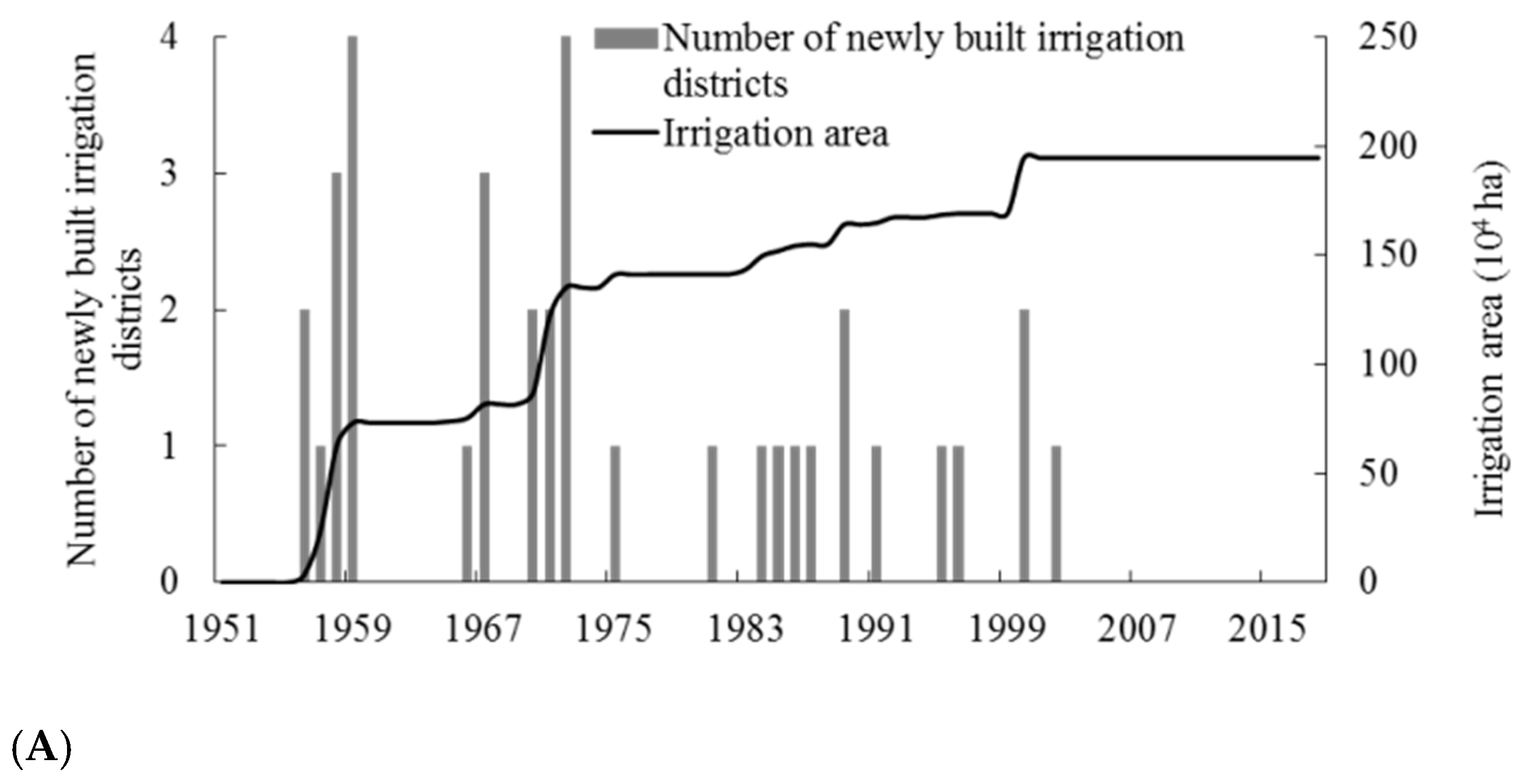
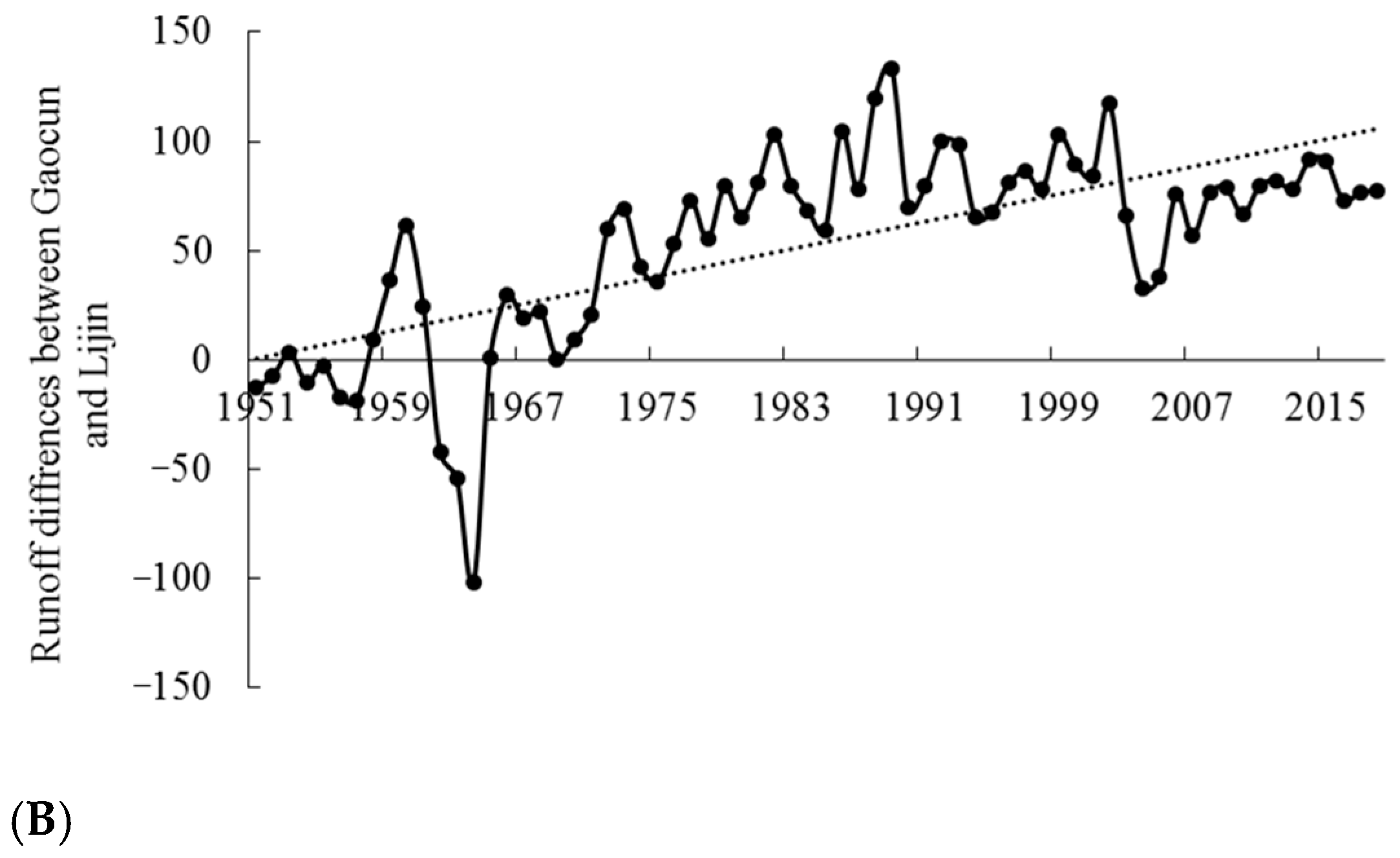
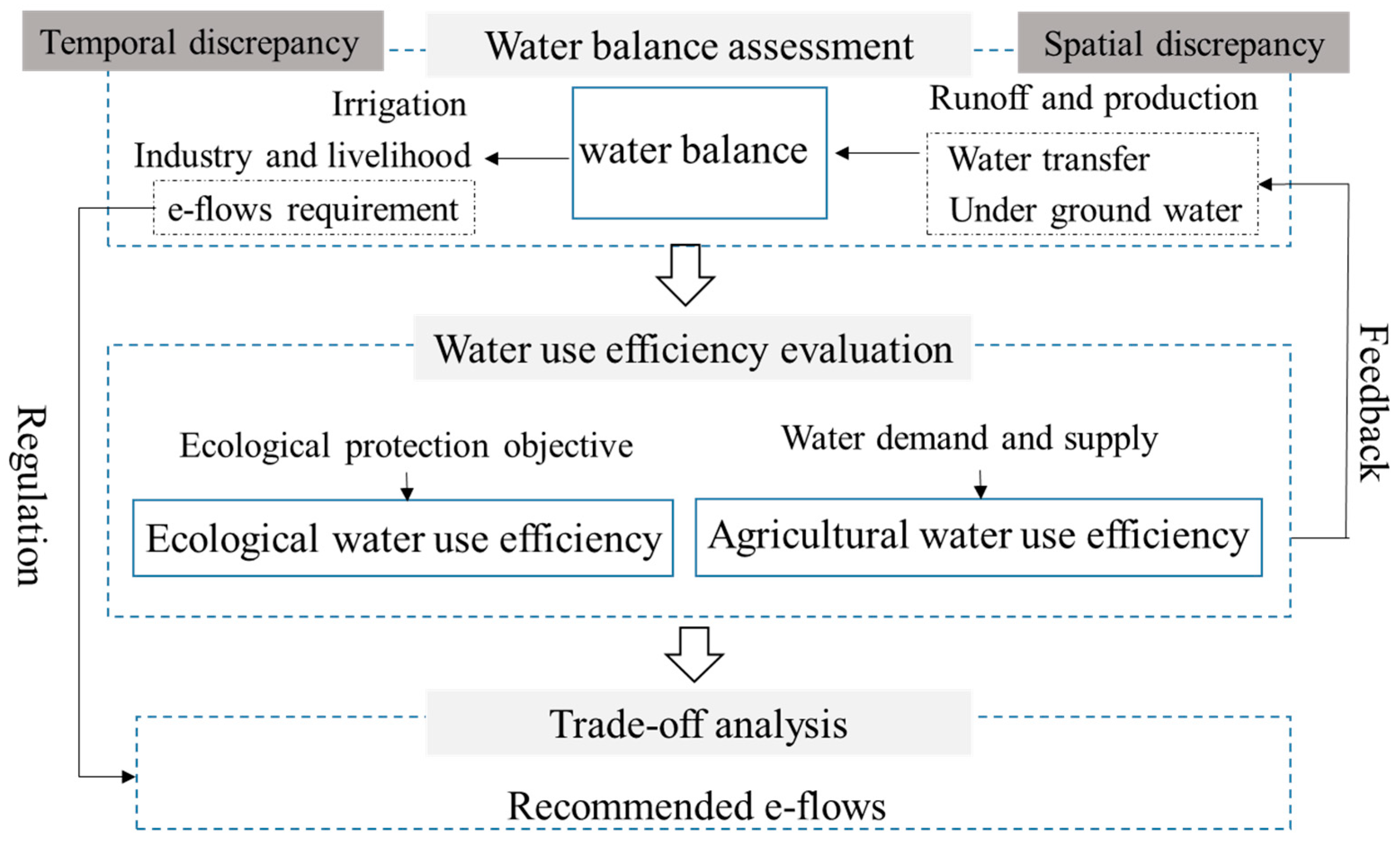

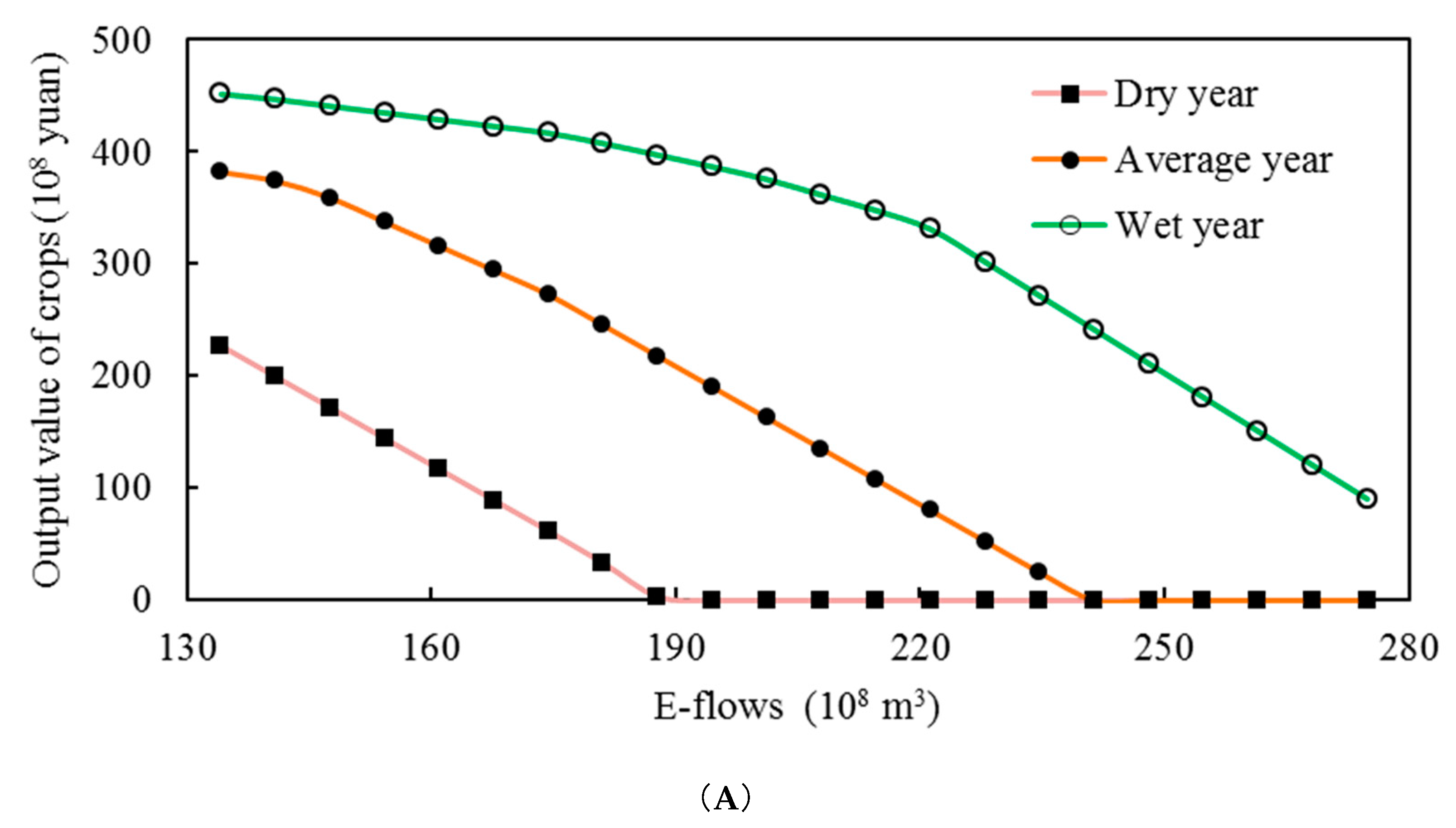

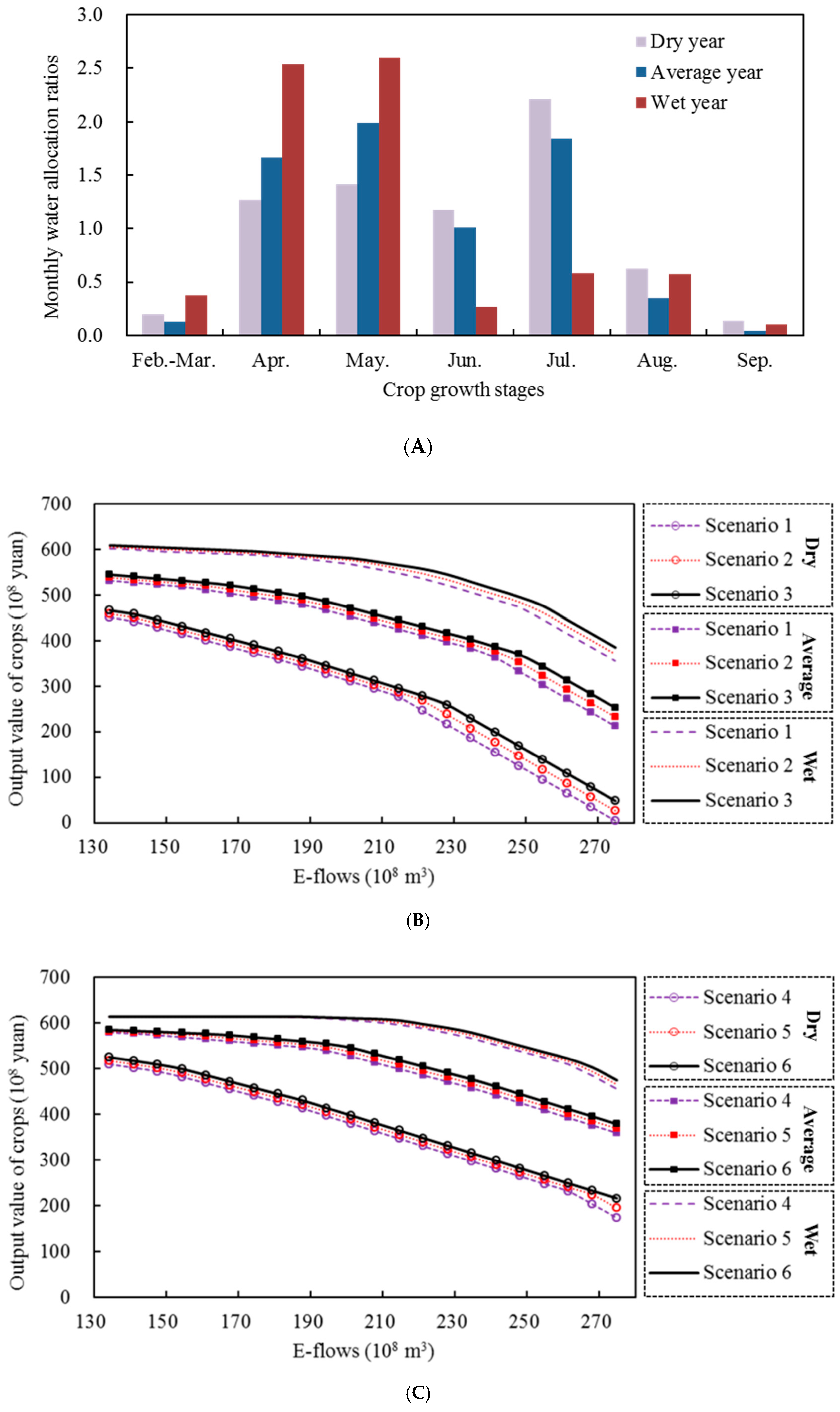
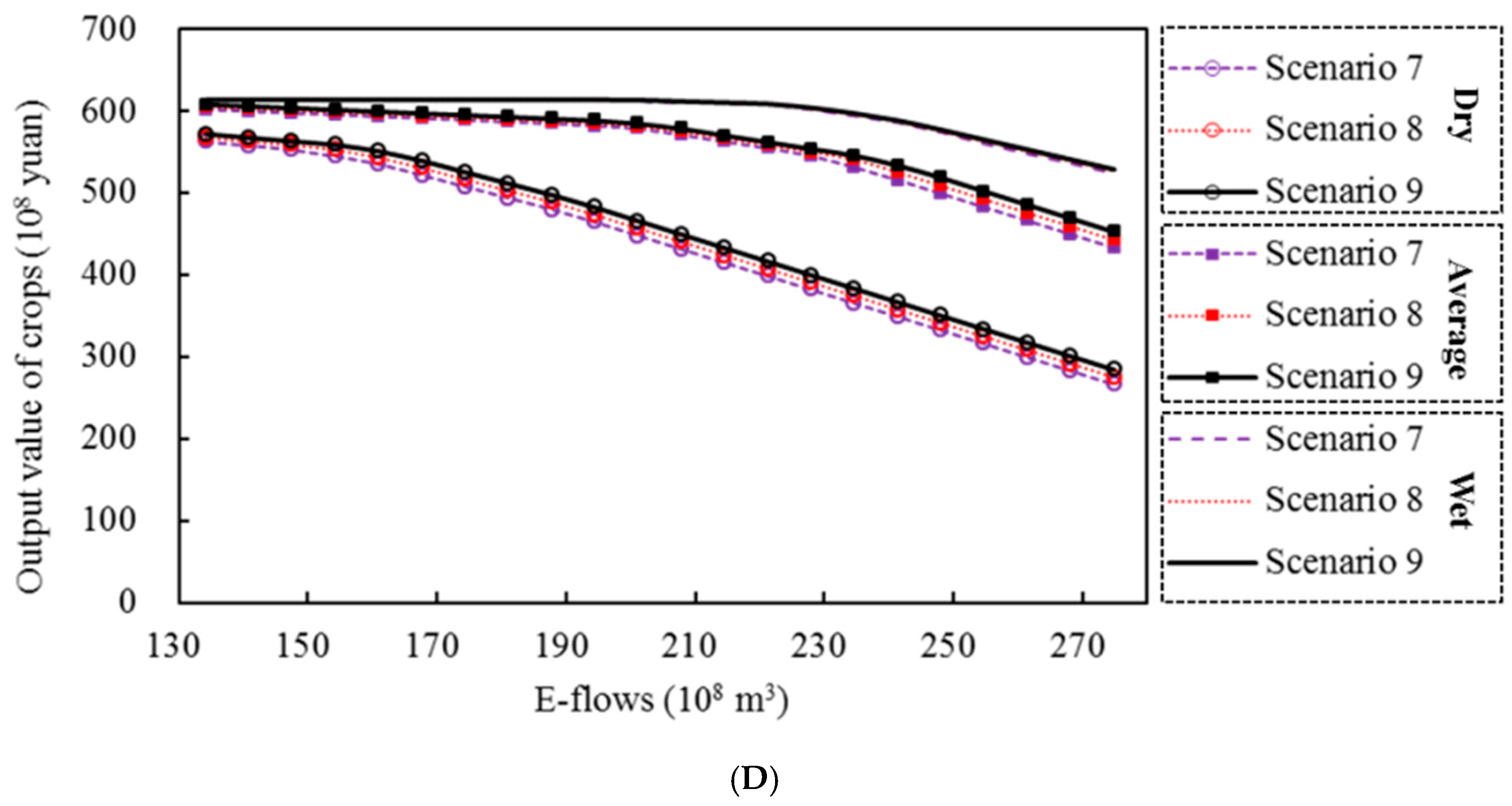

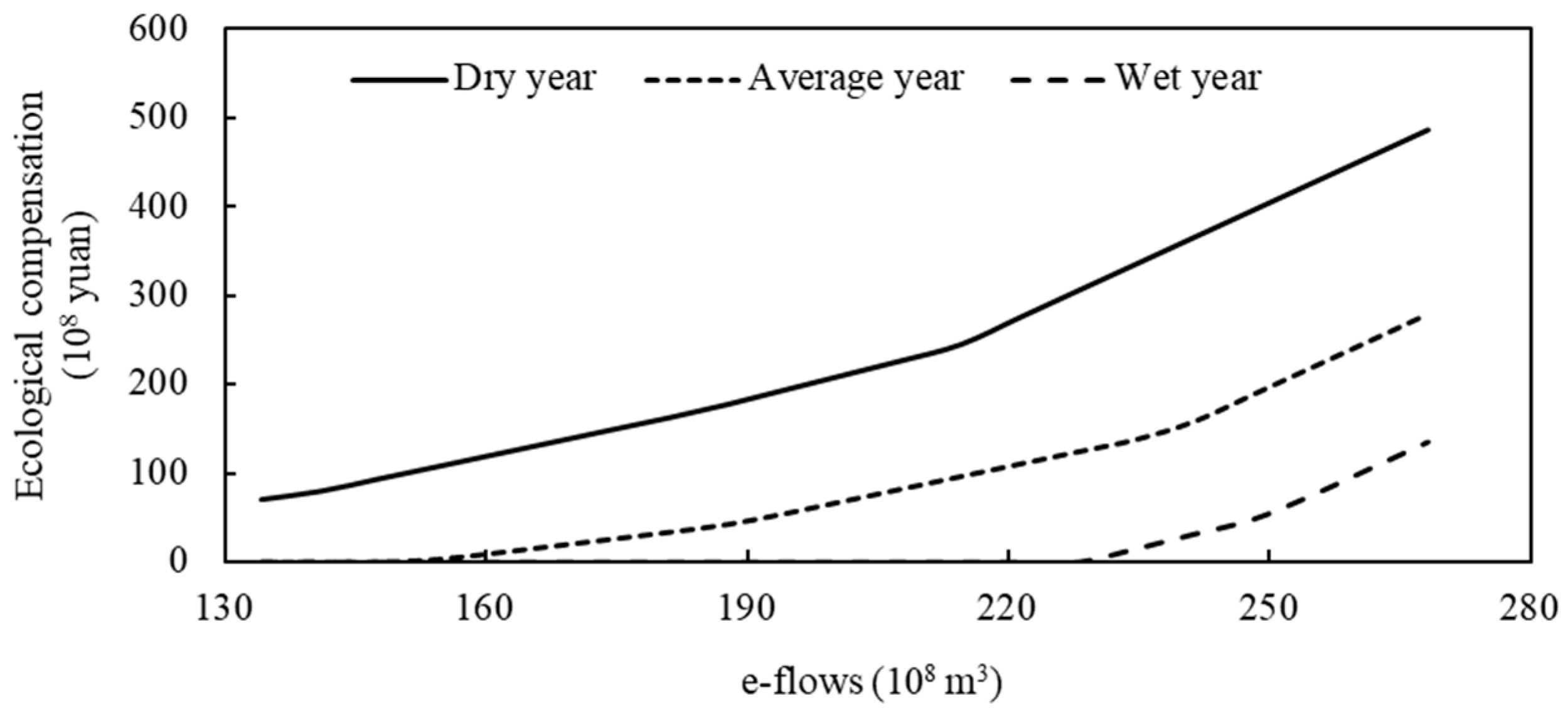
| Scenarios | Water Resources Allocation Scheme (108 m3) | |
|---|---|---|
| Groundwater Exploitation | South-to-North Water Diversion Project | |
| Baseline | 0 | 0 |
| 1 | 40 (reasonable) | 7.03 (short-term) |
| 2 | 9.63 (medium-term) | |
| 3 | 12.23 (long-term) | |
| 4 | 60 (50% over-exploited) | 7.03 (short-term) |
| 5 | 9.63 (medium-term) | |
| 6 | 12.23 (long-term) | |
| 7 | 80 (100% over-exploited) | 7.03 (short-term) |
| 8 | 9.63 (medium-term) | |
| 9 | 12.23 (long-term) | |
Publisher’s Note: MDPI stays neutral with regard to jurisdictional claims in published maps and institutional affiliations. |
© 2021 by the authors. Licensee MDPI, Basel, Switzerland. This article is an open access article distributed under the terms and conditions of the Creative Commons Attribution (CC BY) license (http://creativecommons.org/licenses/by/4.0/).
Share and Cite
Pang, A.; Zhao, F.; Li, C.; Yi, Y. Rethinking Environmental Flows for the Yellow River Estuary by Trading Off Crop Yield and Ecological Benefits. Agriculture 2021, 11, 116. https://doi.org/10.3390/agriculture11020116
Pang A, Zhao F, Li C, Yi Y. Rethinking Environmental Flows for the Yellow River Estuary by Trading Off Crop Yield and Ecological Benefits. Agriculture. 2021; 11(2):116. https://doi.org/10.3390/agriculture11020116
Chicago/Turabian StylePang, Aiping, Fen Zhao, Chunhui Li, and Yujun Yi. 2021. "Rethinking Environmental Flows for the Yellow River Estuary by Trading Off Crop Yield and Ecological Benefits" Agriculture 11, no. 2: 116. https://doi.org/10.3390/agriculture11020116
APA StylePang, A., Zhao, F., Li, C., & Yi, Y. (2021). Rethinking Environmental Flows for the Yellow River Estuary by Trading Off Crop Yield and Ecological Benefits. Agriculture, 11(2), 116. https://doi.org/10.3390/agriculture11020116







